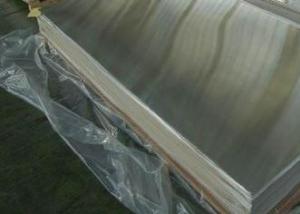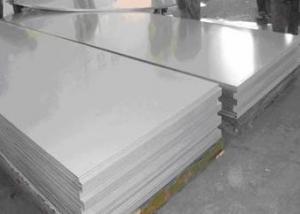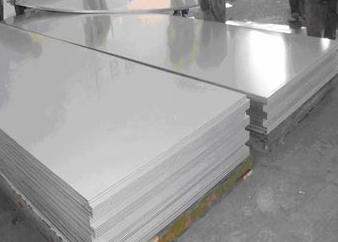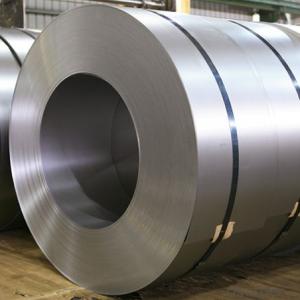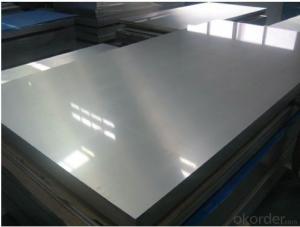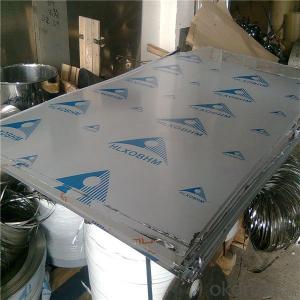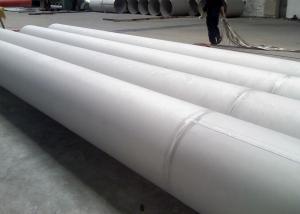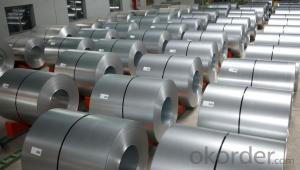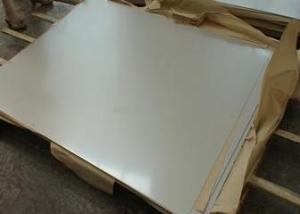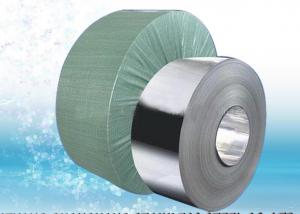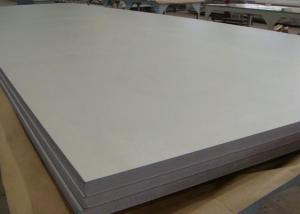SUS304L Stainless Steel Sheet
- Loading Port:
- China Main Port
- Payment Terms:
- TT or LC
- Min Order Qty:
- 1 Ton m.t.
- Supply Capability:
- 1000 Tons Per Month m.t./month
OKorder Service Pledge
OKorder Financial Service
You Might Also Like
304L stainless steel sheet
1. Chemical composition
|
C |
Si |
Mn |
P |
S |
Ni |
Cr |
|
Max0.03 |
Max1.00 |
Max2.00 |
Max0.045 |
Max0.03 |
9.0-13.0 |
18.0-20.0 |
2. Mechanical properties
|
Yield Strength |
Tensile |
Elongation |
Hardness (HV) |
Hardness (HRB) |
|
≥175 |
≥480 |
≥40 |
≤200 |
≤90 |
3. Standard: AISI, ASTM, GB, EN, DIN, JIS
4. Surface: 2B, NO.1, BA, NO.4, Hairline, SB, Mirror finish, Anti-skid, Cherkered etc.
5. Size: Thickness: 0.3-3mm (cold rolled), 3-40mm (hot rolled)
Width: 1000mm or 1219mm or 1240mm for cold rolled, 1500mm for hot rolled.
Length: As customers' request.
6. MOQ: 1 Ton
7. Payment terms: T/T or L/C
8. Packing: Seaworthy package with wooden or Iron pallets with the paper and the steel strip, or as customers' request.
9. Delivery time: Usually about 7 days after we confirming the order, or according to your quantity.
If you have any question or demand, pls feel free to contact me.
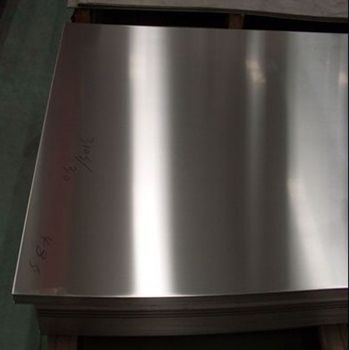
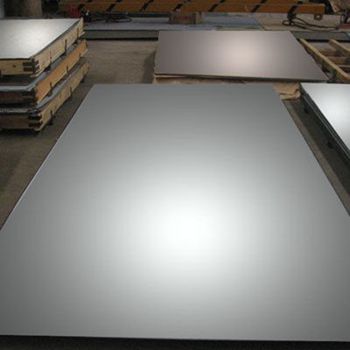
- Q: How do stainless steel strips resist intergranular corrosion?
- Stainless steel strips resist intergranular corrosion primarily due to the presence of chromium in their composition. Chromium forms a protective oxide layer on the surface of the steel, which acts as a barrier against corrosive elements. This oxide layer is self-repairing, ensuring the strips retain their corrosion resistance even if damaged. Additionally, stainless steel strips are often alloyed with other elements such as molybdenum, which further enhances their resistance to intergranular corrosion.
- Q: What are the standard dimensions of stainless steel strips?
- The standard dimensions of stainless steel strips can vary depending on the specific application and industry requirements. However, there are some common standard dimensions that are widely used. Stainless steel strips typically come in various widths ranging from 0.025 inches to 24 inches. The thickness of these strips can range from 0.001 inches to 0.1875 inches. Lengths can vary as well, but standard lengths are often available in coils or rolls of up to 100 feet. It is important to note that these dimensions are not fixed and can be customized based on the specific needs of the project or application.
- Q: Are stainless steel strips resistant to nitric acid?
- Stainless steel strips are typically resistant to nitric acid. Renowned for its exceptional corrosion resistance, stainless steel shows commendable resilience against various acids, including nitric acid. Nevertheless, the degree of resistance may fluctuate based on the particular grade or alloy of stainless steel employed, alongside the nitric acid's concentration and temperature. It is highly advisable to seek guidance from the stainless steel manufacturer or supplier for precise details regarding their products' resistance to nitric acid in your specific application.
- Q: Can stainless steel strips be formed into different shapes?
- Yes, stainless steel strips can be formed into different shapes. Stainless steel is a malleable material that can be easily shaped and manipulated. It can be bent, folded, rolled, or stretched into various forms and configurations. This flexibility allows stainless steel strips to be used in a wide range of applications, such as in the manufacturing of appliances, automotive parts, construction materials, and more. The ability to form stainless steel strips into different shapes makes it a versatile material that can be customized to meet specific design requirements.
- Q: Can stainless steel strips be used in food processing equipment?
- Food processing equipment can indeed make use of stainless steel strips. Within the food industry, stainless steel is a favored choice due to its numerous desirable qualities. Its exceptional corrosion resistance is particularly crucial in an environment where contact with both food and water is common. Furthermore, stainless steel is easy to clean and sanitize, making it well-suited for food processing equipment that requires frequent washing. In addition, stainless steel does not react with food, ensuring that no harmful substances are leached into the processed products. Its durability and strength also guarantee that the equipment can withstand the rigorous demands of the food processing industry. In summary, stainless steel strips are a dependable and secure option for food processing equipment.
- Q: Are stainless steel strips resistant to humidity?
- Stainless steel strips demonstrate resistance to humidity. This is due to the exceptional corrosion resistance of stainless steel, which encompasses its ability to withstand humidity and moisture. The inclusion of chromium in stainless steel generates a protective layer on the surface, preventing oxidation and corrosion. As a result, stainless steel strips exhibit high resistance against the impacts of humidity, rendering them a suitable option for a range of applications in humid settings, including kitchen appliances, outdoor structures, and industrial equipment. However, it should be noted that extended exposure to exceedingly high humidity or corrosive environments may still lead to some degree of corrosion, although it would be significantly less when compared to other materials.
- Q: Can stainless steel strips be used in the electronics manufacturing industry?
- Yes, stainless steel strips can indeed be used in the electronics manufacturing industry. Stainless steel is a versatile material known for its strength, durability, and resistance to corrosion. These properties make it an ideal choice for various applications in the electronics industry. Stainless steel strips are commonly used for the fabrication of electronic components, such as connectors, terminals, and shielding. The strips can be easily shaped and formed into specific sizes and shapes, allowing for precise manufacturing of intricate electronic parts. Furthermore, stainless steel's resistance to corrosion is crucial in electronic devices that are exposed to harsh environments or moisture. It ensures the longevity and reliability of the components, preventing premature failure. Moreover, stainless steel strips can be used in the production of electronic enclosures, cabinets, and frames. These structures provide protection and support for delicate electronic circuitry, effectively shielding it from external factors like electromagnetic interference or physical damage. In addition to its mechanical properties, stainless steel also offers excellent thermal conductivity. This feature is advantageous in the electronics industry as it helps dissipate heat generated by electronic devices, ensuring their optimal performance and preventing overheating. Overall, stainless steel strips are a valuable material in the electronics manufacturing industry due to their strength, durability, corrosion resistance, and thermal conductivity. They play a crucial role in the production of electronic components, enclosures, and other necessary structures, contributing to the reliability and performance of electronic devices.
- Q: Are 111 stainless steel strips suitable for electrical conductivity applications?
- No, 111 stainless steel strips are not suitable for electrical conductivity applications. Stainless steel is known for its excellent corrosion resistance and strength, but it is not a good conductor of electricity. For electrical conductivity applications, metals like copper, aluminum, or silver are preferred due to their high conductivity properties.
- Q: Can stainless steel strips be used in the food processing industry?
- Yes, stainless steel strips can be used in the food processing industry. Stainless steel is highly resistant to corrosion, easy to clean, and does not react with food or alter its taste. This makes it an ideal material for equipment, machinery, and tools used in food processing, ensuring hygienic and safe production processes.
- Q: What are the different types of stainless steel strip alloys?
- Some of the different types of stainless steel strip alloys include austenitic stainless steel, ferritic stainless steel, martensitic stainless steel, and duplex stainless steel.
Send your message to us
SUS304L Stainless Steel Sheet
- Loading Port:
- China Main Port
- Payment Terms:
- TT or LC
- Min Order Qty:
- 1 Ton m.t.
- Supply Capability:
- 1000 Tons Per Month m.t./month
OKorder Service Pledge
OKorder Financial Service
Similar products
Hot products
Hot Searches
Related keywords
